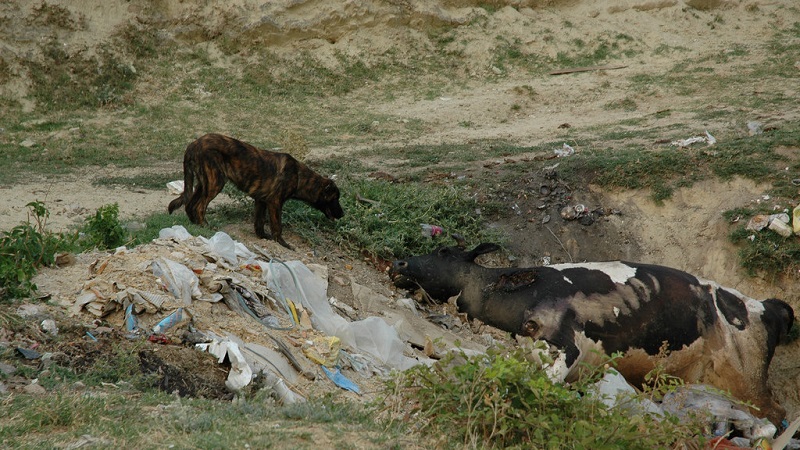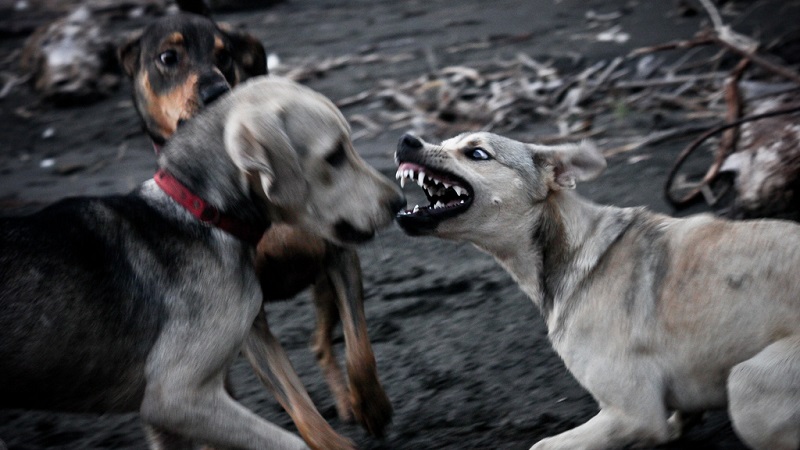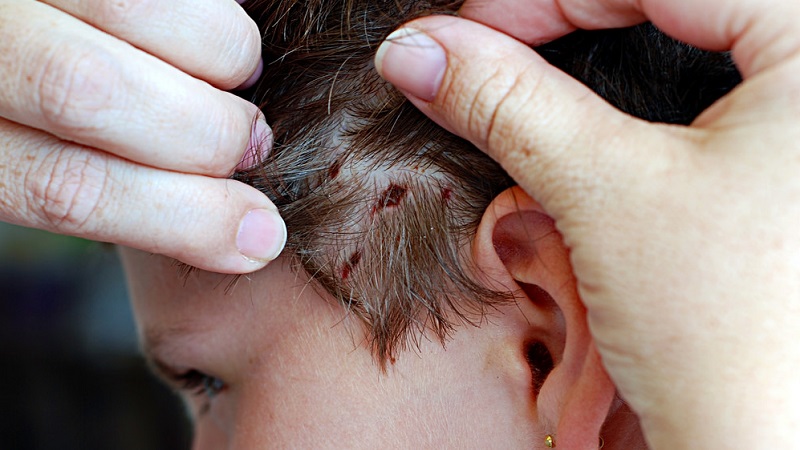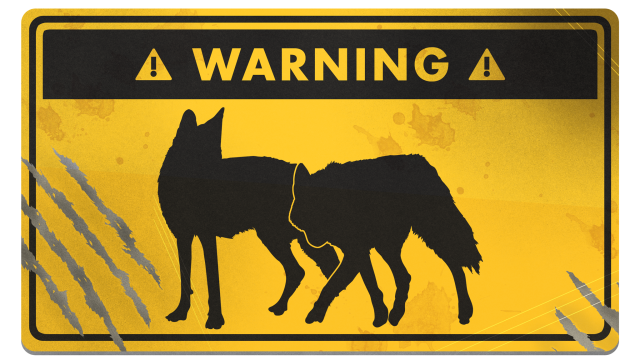There is no national record for keeping track of dog attacks in Australia, but it is estimated that there are 10,000 dog attacks annually, with over 1400 resulting in hospitalisations. Between 2000 and 2003, there were more than 25 deaths attributable to dog attacks — more than sharks and venomous snakes combined. In short, man’s best friend is one of the deadliest animals.
Illustration by Sam Woolley. Photos by Jason Rogers, Jakob Christensen, Julie.
A majority of dog attacks are caused by people’s pets that have either gotten loose or weren’t properly leashed to begin with, but some attacks are by stray or feral dogs.
Feral dogs, sometimes referred to as wild dogs or street dogs, are free-ranging, non-domesticated animals that are not and never were somebody’s pet. They’re usually afraid of people, but can be far more dangerous than a lost or abandoned pet (stray) if they’re cornered or starving.
According to the Internet Center for Wildlife Damage Management, feral dogs usually form communities that travel together, and they often have rendezvous sites like wolves. They tend to scavenge for food, like garbage and roadkill, around human populations, but they have been known to hunt in packs as well. When feral dogs go hunting, it’s usually for livestock, neighbourhood pets and, occasionally, people who are in the wrong place at the wrong time.
And don’t think feral dogs are something you’ll only find in rural areas or third-world countries. Feral dog packs can be found in almost any city, from Brisbane in Australia, to Dallas in the US, where a woman was recently mauled and bitten over 100 times in the middle of the street.

If you encounter a single dog you’re not familiar with, be it a stray, feral or a dog you’re sure is somebody’s pet, the CDC recommends you avoid it — even if it seems like it’s lost or needs help. This goes double for dogs that are sleeping, eating or caring for puppies. Even if it’s obvious that the dog is someone’s pet, an unleashed dog can be dangerous, especially for children.
If an unfamiliar dog approaches you, do not run, panic or make loud noises. Stay motionless, keeping the side of your body facing the dog while avoiding direct eye contact. Say things like “No” or “Go Home” in a deep, firm voice and slowly raise your hands to cover your neck while keeping your elbows in. Now wait for the dog to leave or begin to slowly back away.
If the dog charges you, it’s still important to stand as still as possible. As Dr Sofia Yin, DVM, MS, explains, dogs charge for one of two reasons: Either because they are scared and know offence is their best defence, or because you or another person in the vicinity did something that excited them and made them think they’re being rewarded. People’s pets can get caught in a self-reinforced feedback loop where they “play” a little too hard and don’t know any better. If you yell and move around frantically, the dog will think you’re playing along and won’t stop.
If the dog is clearly being aggressive, not playing (growling, snarling, barking), or obviously feral (dirty, no collar, not reacting to commands), Yin recommends you try and put something between you and the animal. A backpack, purse, jacket or even a shoe can make for a great shield. Look at the dogs’ body language so you can prepare to block attacks. Tension in the body, raised hackles (the hair along the dog’s back) and ears that are flat against their head are things to watch for.
Don’t try to hit the dog with the item, though, as this can make the dog even more aggressive. Just try to back away slowly. If the dog knocks you down, curl into a ball with your head tucked, make fists with your hands to protect your fingers and use your hands and arms to cover your ears and neck.

If you encounter a pack of feral dogs, you’ll use most of the same tactics, but there are a few more things you need to consider. As Cesar Millan (the “Dog Whisperer”) explains, the pack will split up and try to come at you from multiple angles. The more submissive dogs of the pack will try to circle around behind you while the dominant dogs of the pack will approach you head on. Don’t let any dogs get behind you if you can help it.
If you can find any sticks or stones to throw at the dogs, grab them and focus on the alpha or one of the more dominant dogs of the pack. If you can scare the leaders off, the rest will follow. Also, if you have any weapons on you, like a baton or a knife, keep them handy. Lastly, if you can spot any high ground, like the top of a car, the back of a ute or an electrical box, slowly back your way toward it so you can climb up if you need to.
If you get bitten, the CDC recommends you wash your wounds with soap and water as soon as possible. After you’ve cleaned your wounds, seek immediate medical attention to prevent infection, especially if the wound won’t stop bleeding, you’ve lost function in the bite area, you can see muscle or bone tissue or you’re experiencing extreme pain. The same goes if you develop a fever after receiving the wound, or it becomes red, painful, warm to the touch or swollen.

This is part of Lifehacker’s Animal Attacks Series. As capable as we humans think we are, bears, snakes, wolves, sharks and even bees can turn a fun day outside into a harsh, potentially life-threatening reality check. Here’s what to do when you find yourself face to face with some of the deadliest beasts in the great outdoors.

Comments
8 responses to “How To Survive A Dog Attack”
Heads up for Australians – no rabies in dogs here.
Thanks for the heads up. We’ve fixed it now!
Cheers,
Spandas
Unless some mug brings their dogs in on a private plane
one time on the way to work i drove past 2 adult german shepherds walking around without a owner. i kept going, but then something inside me told me to turn around and go back, so i did. i parked about 20 or 30 meters up from them got out slowly and got down low and called them over in a pleasant non-threatening tone.
in hindsight, stupidest thing i could have done, but, i was lucky and they came over with tales wagging and were happy to roll over and have a tummy rub. also thankfully they had a number i could call. and the lady who owned them was about 5kms away on the other side of the suburb driving around looking for them.
i tend to make it a habit to pull over for wandering dogs, mainly because im a massive dog lover, and i havnt had any issue so far, i realise its not the smartest thing, and i wouldnt pull over for certain breeds.
i have a daughter now who is 4 and im much more cautious about dogs with or without leads and warn her constantly to not go over to dogs we don’t know, because its true, you just never know.
thanks for the write up, some interesting and logical points there ill be sure to remember.
Seriously, you say to avoid a dog you don’t know even if your sure it’s someone’s pet or is lost.
I guess if your dog/child/self is lost one day you would want everyone to ignore that too.
You make me sick.
A child has a very low chance of attacking a stranger. With a dog the chance is not so low.
A toddler will not bite/Attack you.
A dog can.
Big difference.
1 is an animal, The other is a human being.
If you do have a stick, best to poke like a spear towards the dog, not swing. Aim (if at all possible) to thrust the stick down the dog’s throat.
In NSW the law permits one to injure, destroy or seize an attacking dog; attacking is defined as rushing at, harassing, etc. Its in the Companion Animals Act. Unfortunately there’s nothing you can do about the owner of an off leash dog except complain to your local council. The fine for off-leash is about $1000, from memory.